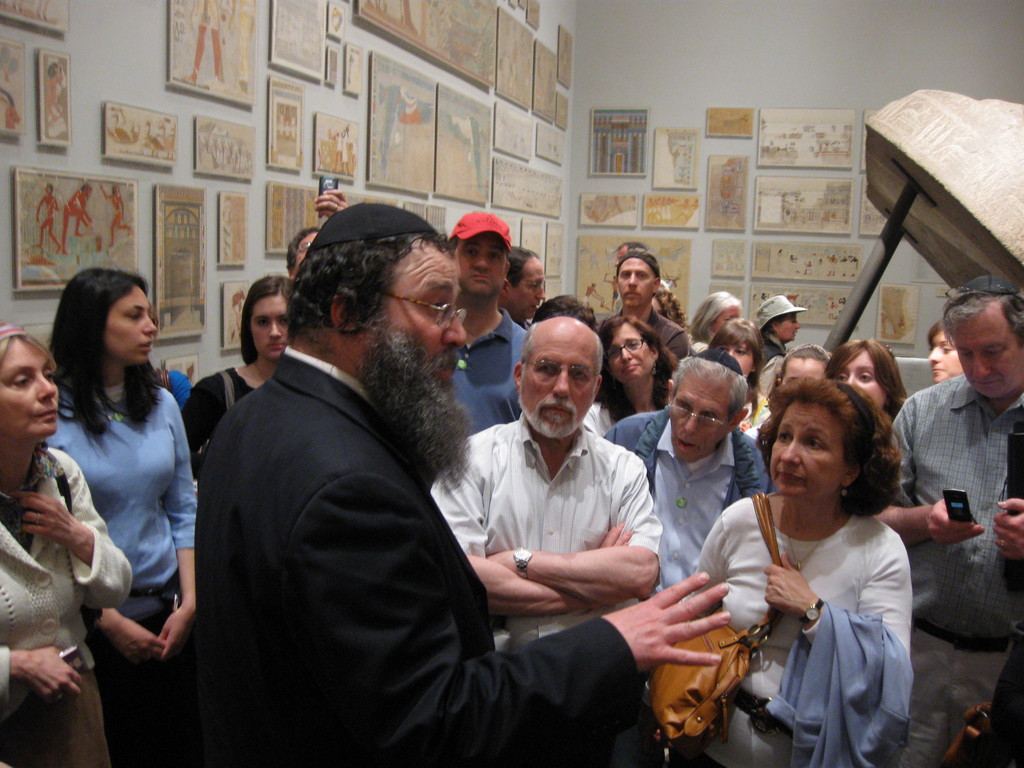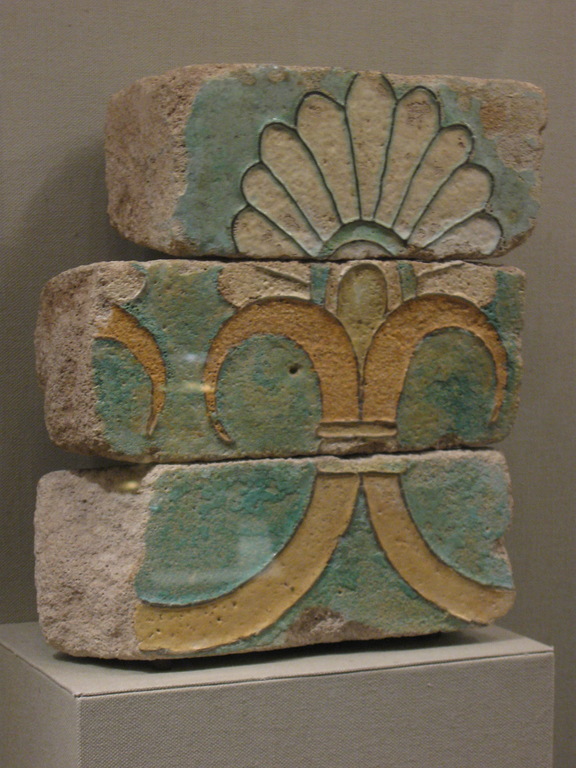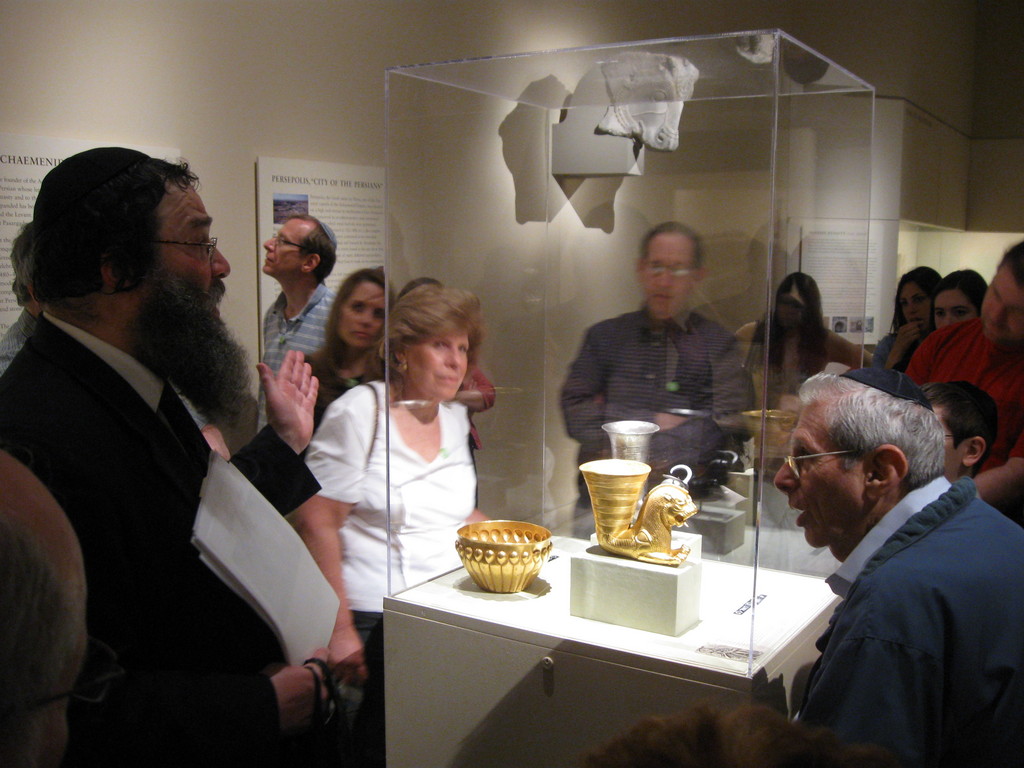‘Tanach tour’ uncovers Jewish history at the Met
Guide responds to bible critics with answers ‘buried’ in plain sight
By Mayer Fertig
Issue of July 17, 2009 / 25 tammuz 5769
On a sunny afternoon in Jerusalem in 1987 Rabbi Yehuda Landy was explaining the finer points of the famous large-scale model of the Beis Hamikdash, the Holy Temple, then located at the Holyland Hotel.
From memory, he confidently marshaled a stream of disparate Biblical and Talmudic sources to make his points. His intended audience was a large group of young men from Yeshiva Neveh Zion where Rabbi Landy, then unmarried, was a respected, popular young member of the faculty. But as his extemporaneous presentation unfolded a curious thing began to happen: members of a Christian tour group from Scandinavia standing nearby began to abandon their own blond haired, blue-eyed guide and drifted over to the group led by the bearded rabbi. One by one, two by two, they came, until the Christian guide stood by himself.
22 years later Rabbi Landy still casts the same type of spell. Friendly and
approachable, with a wry sense of humor, and an encyclopedic knowledge of Tanach (Five Books of Moses, Prophets and Scriptures), Talmud and Jewish history, as well as of the secular academic field known as bible criticism, he offers guided tours by appointment only at a number of the world’s great museums, including the Metropolitan Museum of Art in New York, the Oriental Museum in Chicago, the British Museum in London, the Louvre in Paris and, of course, the Israel Museum in Jerusalem.
Rabbi Landy, never without a sefer to put “downtime” to good use, said his Tanach Tours, as he calls them, can “show the Torah world there is plenty of archeology that is worth knowing,” while at the same time providing an educated response to those who would cast doubt on the Torah’s account of history.
“We live in a world with bible criticism where they say, ‘We don’t have the evidence,’ Rabbi Landy observed. “Well, there’s plenty that has been found. There are plenty of archaeological artifacts that match what we know from Tanach.”
He also lectures annually at Hebrew Academy of Nassau County (HANC) using PowerPoint to illustrate his subjects, has taken Yeshiva University High School for Boys (MTA) students to the Met and, several years ago, delivered a series of four lectures at Yeshiva University.
On a warm Sunday in late April, 40 people, including several families from West Hempstead, followed Rabbi Landy around the Metropolitan Museum of Art in Manhattan. Most had been there before, some many times. But each saw the collections he toured through new eyes — Jewish eyes, if you will.
In the Near East Department he traced “the footsteps of Avraham Avinu” — Avraham’s journey from Ur Kasdim to Charan — and discussed the findings of an archaeological dig at Ur Kasdim called, “The Royal Tombs of Ur.” Standing in one transplanted room from “a typical, massive Assyrian palace” discovered in the 1850’s, he described the kings who ruled that part of the world in the 7th and 8th centuries B.C.E — kings who, upon their deaths, were buried with all of their (poisoned) servants.
“This was the society that Avraham Avinu was born into,” Rabbi Landy noted.
Pointing out intricately carved lions from the time of Nebuchadnezzar (“no doubt a megalomaniac”) he explained that interested parties could see more of the lions where they had come from originally, in Iraq (“not recommended,” he said).
The Metropolitan Museum of Art has a fair amount of material related to Purim, including several colorful bricks excavated from the king’s palace at
Shushan, where the Purim story took place.
Referring to a king known as Chashriash, mispronounced by the Greeks as Xerxes, “Most believe he is Achashverosh,” Rabbi Landy said.
Strongly disputing claims by some academics that Megillat Esther was written in the Hellenistic period — “That’s nonsense, in my opinion,” he said firmly — Rabbi Landy pointed out that the Megillah is replete with Persian words, “but not one Greek word.”
The tour spun on for more than two fascinating hours — touching on Egypt (Ramses II is “believed by most scholars to have been king” when the Jews left Egypt), the Dead Sea Scrolls, the missing 10 tribes, and the destruction of the second Bais Hamikdash.
“I thought it would be interesting to see [the Met] through a Jewish perspective, through the Tanach,” said Dina Selesny of West Hempstead. She’s been through portions of the museum four times in the past, including trips with HANC sixth graders. On her fifth visit she saw it “in a whole different light,” she said.
“I haven’t been here in a while,” said her daughter, Elizabeth Selesny, who is going into 11th grade at Yeshiva University High School for Girls (Central.) Now, “I see it through a more mature perspective; through a Jewish perspective.”
“I was fascinated to see how he brought out the Jewish history,” said Teaneck resident Susan Presby. “If you think about it, there is no ‘Jewish era,’” just Jewish history in every time and place. She and her husband, Lenny, visit the museum once a month or so “and we’ve walked right by this,” he said.
Rabbi Landy will be in the U.S. for about ten days this month, leading Tanach Tours at museums in NY, Chicago and possibly Baltimore. Schedule permitting, he is also available to deliver PowerPoint presentations about the Three Weeks (Bein HaMetzorim) at shuls, bungalow colonies and summer camps. For information, rates and reservations e-mail him directly at nzion [at] smile.net.il. He plans to lead a tour at the Metropolitan Museum of Art this Sunday, July 19. Email to reserve a slot. Rabbi Landy also leads tours around Israel.

 67.0°,
Mostly Cloudy
67.0°,
Mostly Cloudy 















